Rats, often misunderstood, are fascinating creatures epitomizing adaptability and survival. This article spotlights some of the largest rat species found in the U.S., going beyond the typical urban dwellers that might come to mind when one thinks of rats.
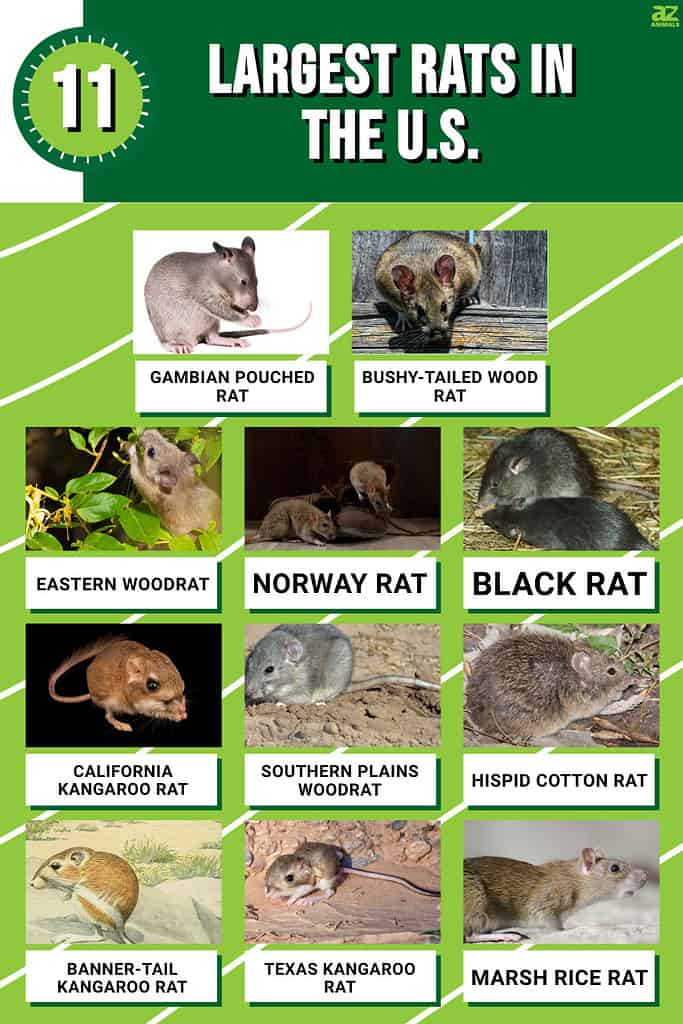
The rat family, known scientifically as Muridae, includes an extraordinarily diverse array of rodents. Across the United States, there are numerous large rat species, each possessing unique characteristics and habitats.
From the substantial Gambian Pouched Rat to the smaller but equally interesting Texas Kangaroo Rat, this article explores these intriguing creatures in depth.
#1 Gambian Pouched Rat (Cricetomys gambianus)

Gambian pouched rats are the second largest rat species in the world!
©iStock.com/Farinosa
The Gambian Pouched Rat reigns as the largest in our list of rat species found in the U.S. It captures our attention with its unique appearance and imposing size. Let’s delve deeper into the details of this fascinating creature.
Appearance and Size
Standing apart from the crowd, the Gambian Pouched Rat boasts a size that outmatches its counterparts. Adults can reach up to 3 feet in length from nose to tail. This distinctive rat has a robust build, large ears, and a long, scaly tail.
What truly sets this rat apart are its cheek pouches. These resemble those of a hamster, stretching from its cheeks to its shoulders. The pouches come in handy for carrying food, a unique adaptation that proves beneficial in the wild.
Where You Might Encounter Gambian Pouched Rats
Originally, the Gambian Pouched Rat hails from Africa. However, it has found its way to the U.S., notably in the state of Florida. There, it inhabits areas with soft soils, which facilitate the digging of burrows.
Life Cycle and Behavior
The life cycle of the Gambian Pouched Rat is as captivating as its size. It possesses a longer lifespan than most rat species, living up to seven years in the wild. Social creatures, these rats emit various vocalizations and scents to communicate.
#2 Bushy-Tailed Wood Rat (Neotoma cinerea)
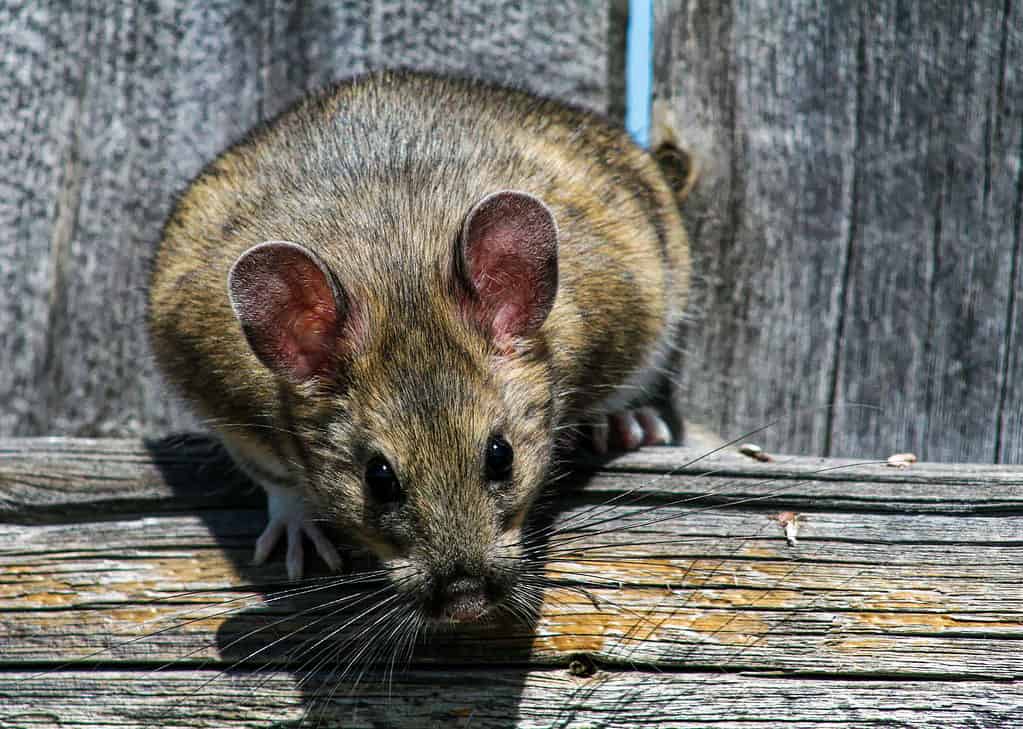
Bushy-tailed woodrats are found in North America and enjoy living in or around rocky places.
©M. Leonard Photography/Shutterstock.com
As we continue our exploration of the largest rat species in the U.S., we encounter the Bushy-Tailed Wood Rat. Despite its somewhat comical name, this creature showcases some truly remarkable traits. Let’s dig deeper into the world of this interesting rat species.
Appearance and Size
Earning its name, the Bushy-Tailed Wood Rat possesses a large, bushy tail, unlike the typical sleek, scaly rat tail. In terms of size, these creatures can grow to impressive lengths of up to 18 inches, tail included. Their sturdy bodies, topped with dense, soft fur, contribute to their robust appearance.
Where You Might Encounter Bushy-Tailed Wood Rats
This rat species prefers the rocky terrains of the western United States, Canada, and as far north as Alaska. Within these environments, they construct elaborate dens or “middens,” often at the bases of trees or within rocky crevices.
Behavior and Diet
The Bushy-Tailed Wood Rat, being nocturnal, engages in its activities during the night. It follows a herbivorous diet, munching on a variety of leaves, fruits, and nuts. However, it doesn’t shy away from an occasional insect or small animal.
#3 Eastern Woodrat (Neotoma floridana)
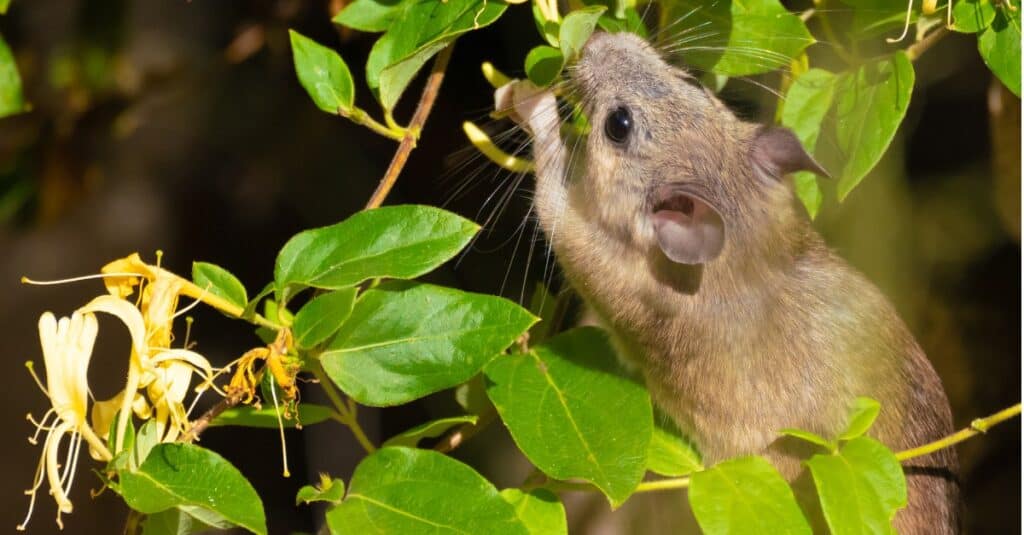
A small Eastern woodrat eating leaves.
©iStock.com/Moment of Perception Photography
Next on our journey through the largest rat species in the U.S. is the Eastern Woodrat. Its distinctive habits and unique habitat preferences set it apart. Let’s take a closer look at this intriguing creature.
Appearance and Size
The Eastern Woodrat presents a robust form with an overall length reaching up to 17 inches, including its tail. With a grey-brown fur coat and large black eyes, it stands out amongst its peers. Its rounded ears and noticeably long whiskers further distinguish this species.
Where You Might Encounter Eastern Woodrats
The Eastern Woodrat inhabits the eastern and central regions of the United States. Its preferred environments include forests, rocky areas, and sometimes even abandoned buildings. Its nest, often constructed of twigs and other plant material, offers a refuge and food storage area.
Behavior and Diet
A nocturnal creature, the Eastern Woodrat spends its nights foraging. It feeds primarily on plant matter, including leaves, fruits, and nuts, but also occasionally insects. These rats showcase a unique behavior of collecting and hoarding various objects, a trait earning them the nickname “packrats.”
#4 Norway Rat (Brown Rat) (Rattus norvegicus)
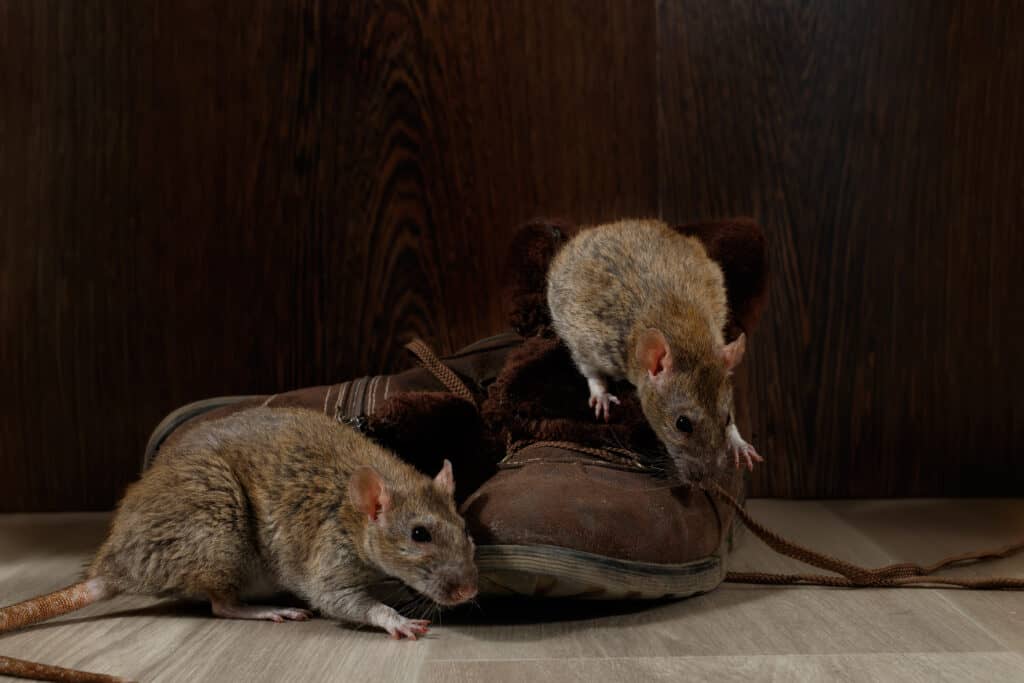
If they have the chance, Norway rats will live in groups growing to hundreds of members, called colonies.
©torook/Shutterstock.com
Next up on our tour of the largest rat species in the U.S. is the Norway Rat, also known as the brown rat. Known for its ubiquity and close association with human habitats, this rat holds a unique position in the rodent world. Let’s delve deeper into the features of this notorious species.
Appearance and Size
The Norway Rat, also known as the brown rat, is an imposing rodent. Its body can measure up to 16 inches in length, with the tail adding another 8 inches. Its coarse brown fur, relatively small ears, and scaly tail differentiate it from other rat species.
Where You Might Encounter Norway Rats
The Norway Rat is highly adaptable and can be found throughout the United States. It prefers habitats that are close to human activity, like city sewers, buildings, and agricultural fields. This rat is a master at adapting to various environments, from basements to fields.
Behavior and Diet
Norway Rats are primarily nocturnal, with peak activity at dawn and dusk. These omnivorous rodents have a varied diet, feeding on everything from trash to grains, fruits, and meats. They are known for their gnawing habit, which keeps their ever-growing incisors in check.
#5 Black Rat (Rattus rattus)

The Roof rat has darker fur, making it easier to distinguish from many others.
©Kilessan / CC BY-SA 3.0 – License
As we journey further into the world of the largest rat species in the U.S., we now encounter the Black Rat. Known for its historical significance and adaptability, this species is worth our attention. Let’s delve deeper into the intriguing features of the Black Rat.
Appearance and Size
With a streamlined body reaching lengths of up to 16 inches, including the tail, the Black Rat, also known as the ship rat or roof rat, is a notable member of the rat family. Its sleek black or dark brown fur, large ears, and slender body differentiate it from its more robust cousin, the Norway Rat.
Where You Might Encounter Black Rats
Originally from Asia, the Black Rat has successfully colonized various parts of the world, including the United States. It is particularly common in coastal cities and port areas. Its habit of nesting high in structures or trees gives it the nickname “roof rat.”
Behavior and Diet
The Black Rat is nocturnal and known for its excellent climbing abilities. It primarily feeds on plant matter, including fruits, seeds, and stems, but can shift its diet based on available food sources. This adaptability contributes to its success as a species.
#6 California Kangaroo Rat (Dipodomys californicus)
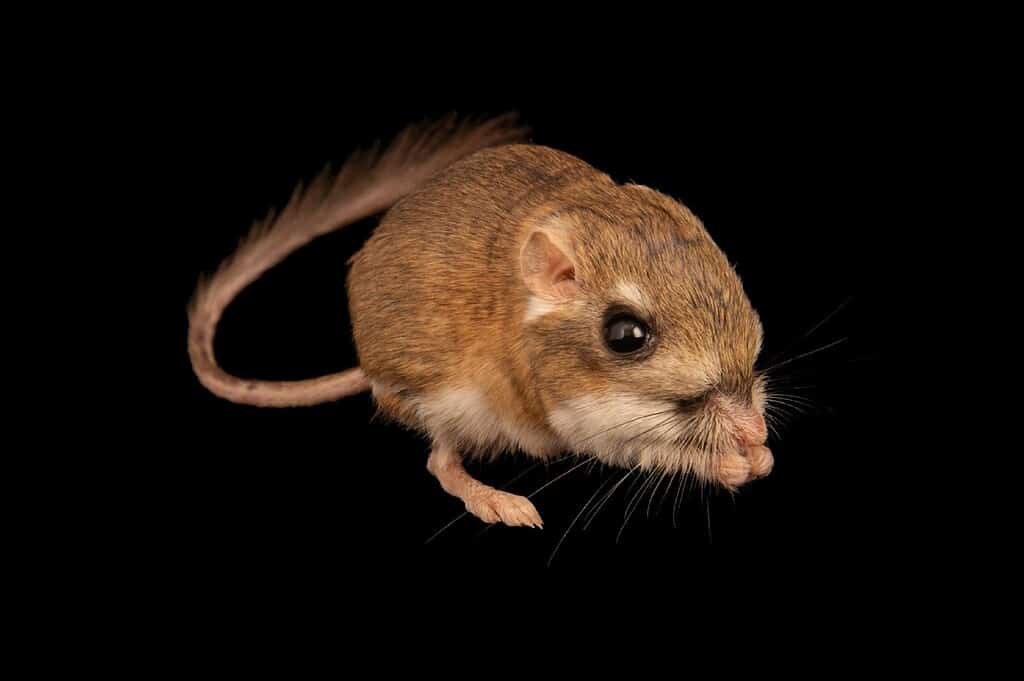
Close-up of a Kangaroo rat in San Bernadino, CA.
©Usha Roy/Shutterstock.com
As we proceed through our exploration of the largest rat species in the U.S., we focus on the California Kangaroo Rat. Renowned for its leaping ability and unique habitat, it’s an apt finale to our exploration. Let’s get to know the California Kangaroo Rat in more detail.
Appearance and Size
The California Kangaroo Rat can reach lengths of up to 16 inches, including its tail. Much like its banner-tailed relative, it has distinctive large hind legs, small front legs, and a tufted tail, all of which contribute to its remarkable hopping abilities.
Where You Might Encounter California Kangaroo Rats
The California Kangaroo Rat inhabits a specific region in the U.S.—the grasslands and woodlands of California. They favor dry, sandy soils that are suitable for their burrowing lifestyle and are particularly prevalent in the coastal areas of California.
Behavior and Diet
The California Kangaroo Rat is a nocturnal animal that feeds primarily on seeds and grains. They have adapted to conserve water efficiently, an essential trait for survival in their dry habitats. Their kangaroo-like leaps are not just for mobility but also serve as an effective evasion strategy against predators.
#7 Southern Plains Woodrat (Neotoma micropus)
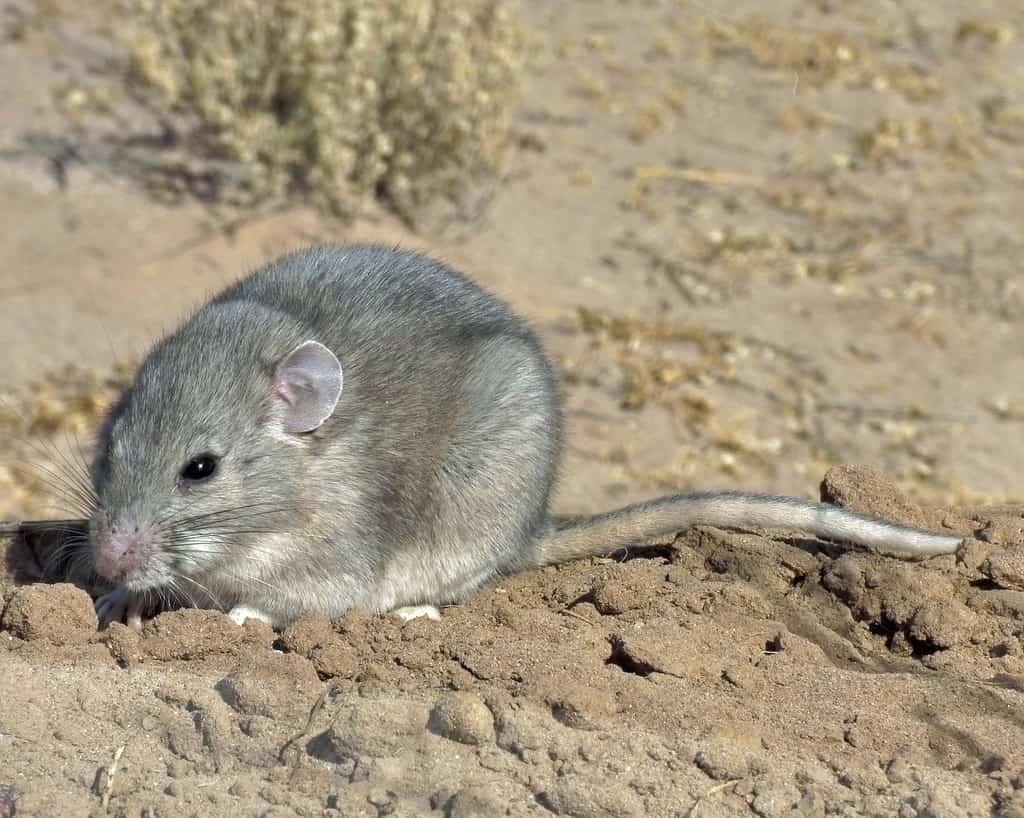
The Southern Plains Woodrat can grow up to 15 inches in length.
©Bongopete / CC BY-SA 4.0 – License
As we move forward on our exploration of the largest rat species in the U.S., we now turn our attention to the Southern Plains Woodrat. This species showcases several unique traits that set it apart. Let’s delve into the world of this remarkable creature.
Appearance and Size
The Southern Plains Woodrat stands as a robust rodent with an average size reaching up to 15 inches in length, including its tail. Sporting a grey-brown coat and a white underbelly, this rat is unmistakably part of the Neotoma genus. Its large eyes and round ears contribute to its distinctive look.
Where You Might Encounter Southern Plains Woodrats
The Southern Plains Woodrat thrives in the arid regions of the southern United States, specifically in Texas and New Mexico. It favors areas with dense, prickly underbrush or cactus growth, which offer protection from predators. Here, it constructs elaborate stick homes known as “middens.”
Behavior and Diet
Like its relatives, the Southern Plains Woodrat is nocturnal and active mainly at night. Its diet consists mostly of plant matter, with a strong preference for cactus. The ingested cactus not only serves as food but also as a valuable water source in its arid environment.
#8 Hispid Cotton Rat (Sigmodon hispidus)

The lifespan of the hispid cotton rat is less than 6 months in the wild, but in captivity, animals have a survival span of up to 23 months of age.
©ALAN SCHMIERER / CC0 – License
As our exploration of the largest rat species in the U.S. continues, we turn our attention to the Hispid Cotton Rat. Noted for its bristly fur and diverse habitat, this rodent is a fascinating member of the rat family. Let’s learn more about the intriguing Hispid Cotton Rat.
Appearance and Size
The Hispid Cotton Rat is characterized by its heavy body, which can reach lengths of up to 14 inches, tail included. It gets its name from the coarse, or hispid, fur that covers its body. Its color varies from dark gray to brown, with a lighter underbelly.
Where You Might Encounter Hispid Cotton Rats
The Hispid Cotton Rat thrives in a wide range of habitats across the United States, from Florida to Arizona and even as far north as Virginia. It typically prefers grassy areas, fields, or the edges of forests, particularly where the ground cover is thick and provides ample protection.
Behavior and Diet
Hispid Cotton Rats are primarily nocturnal and live in complex burrow systems. They mainly feed on plants, including grasses, seeds, and roots, but they can also consume insects and other small animals if available, highlighting their adaptability.
#9 Banner-Tail Kangaroo Rat (Dipodomys spectabilis)
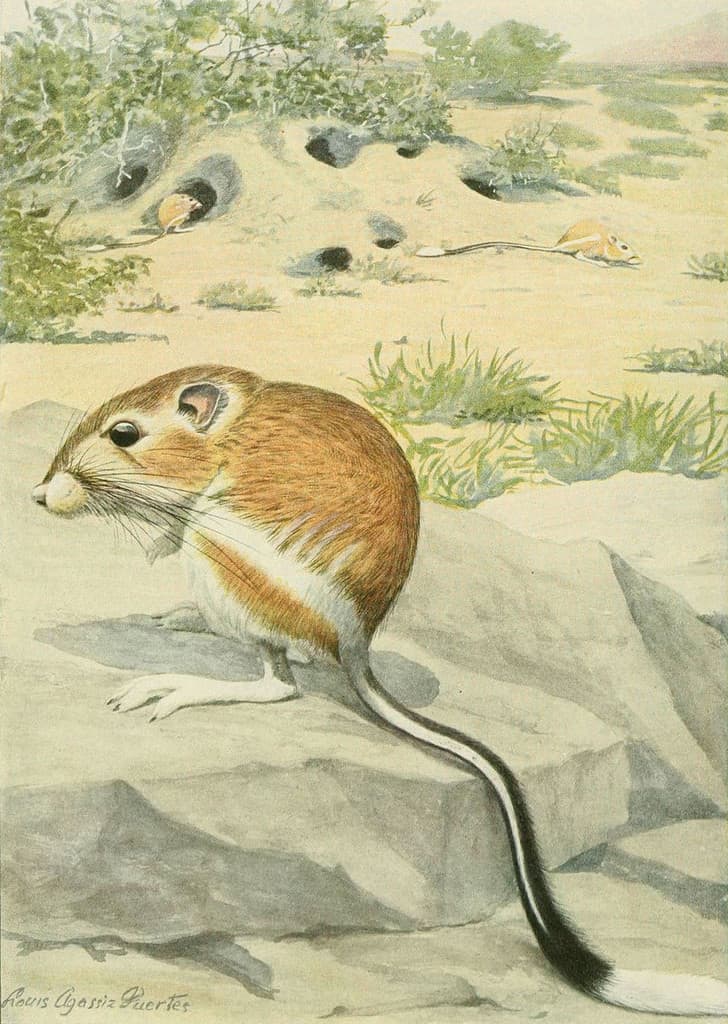
Drawing of a Banner-Tail Kangaroo Rat, which thanks to its large hind legs and tufted tail, has a kangaroo-like appearance.
©Fuertes, Louis Agassiz; Grosvenor, Gilbert Hovey; National Geographic Society (U.S.); Nelson, Edward William / CC0 – License
As we approach the end of our exploration of the largest rat species in the U.S., we now focus on an intriguing creature with an unusual mode of locomotion: the Banner-Tail Kangaroo Rat. Let’s delve into the fascinating world of this distinct rodent.
Appearance and Size
The Banner-Tail Kangaroo Rat is a large rodent that can reach lengths of up to 14 inches, including its tail. It is noted for its large hind legs, small front legs, and distinctive tufted tail—features that contribute to its kangaroo-like appearance.
Where You Might Encounter Banner-Tail Kangaroo Rats
These rats inhabit arid regions of the southwestern U.S., including New Mexico and parts of Arizona. They are uniquely adapted to desert environments and can often be found in sandy soils where they build elaborate burrow systems.
Behavior and Diet
Banner-Tail Kangaroo Rats are nocturnal, spending the day in their burrows to avoid the heat. Remarkably, they can survive without drinking water, getting necessary hydration from the seeds that make up the bulk of their diet. They have a unique method of locomotion, hopping on their hind legs like kangaroos.
#10 Texas Kangaroo Rat (Dipodomys elator)
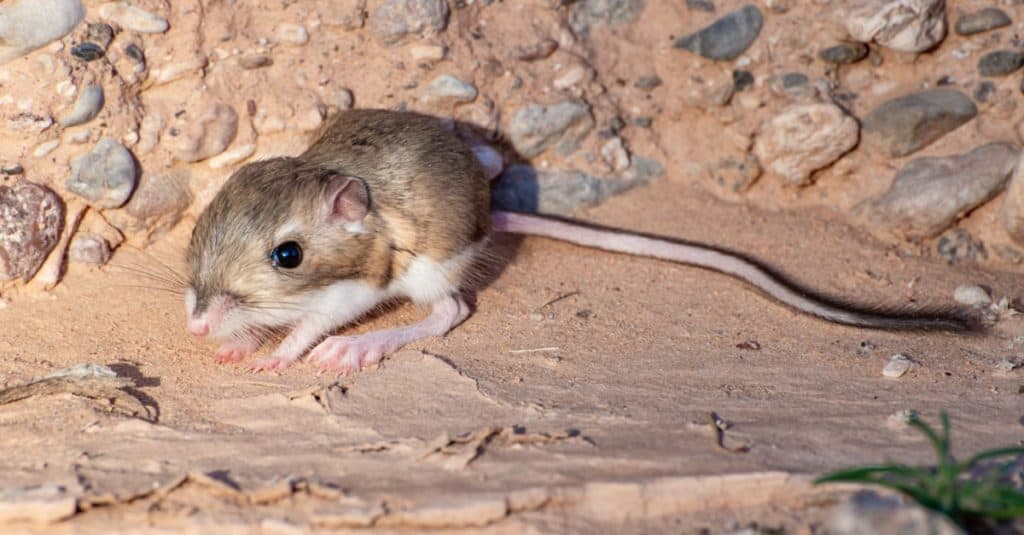
The Texas Kangaroo rat looks very similar to Merriam’s Kangaroo rat pictured here.
©Dominic Gentilcore PhD/Shutterstock.com
As we extend our exploration of the largest rat species in the U.S., we meet the Texas Kangaroo Rat. Known for its unique traits and endangered status, this species is a fascinating case of nature’s adaptability. Let’s dive into the world of the Texas Kangaroo Rat.
Appearance and Size
The Texas Kangaroo Rat can reach lengths of up to 12.5 inches, tail included. It follows the typical kangaroo rat blueprint with large hind legs and a long tail that assists in balance during its characteristic hopping.
Where You Might Encounter Texas Kangaroo Rats
As its name suggests, the Texas Kangaroo Rat primarily resides in Texas, particularly in the grasslands and mixed shrub areas. Its habitat preference includes sandy or gravelly soils, which are ideal for their burrowing lifestyle.
Behavior and Diet
The Texas Kangaroo Rat leads a nocturnal and solitary life, seeking shelter in its burrows during the hot daytime hours. It feeds on seeds and plant matter, and like its other kangaroo rat relatives, it doesn’t need to drink water directly, extracting necessary moisture from its food.
#11 Marsh Rice Rat (Oryzomys palustris)
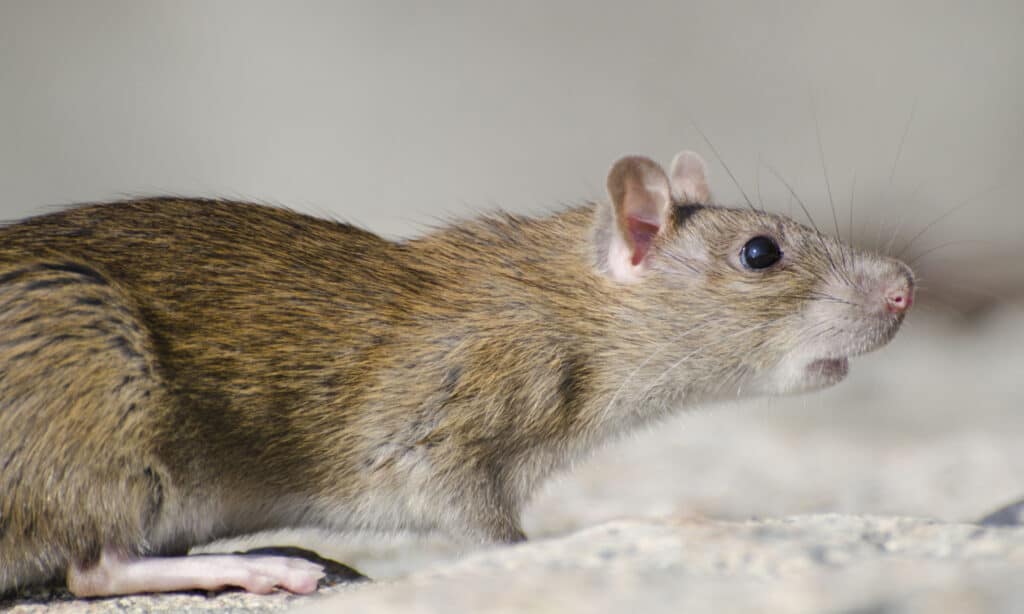
Marsh rice rats usually live for less than one year in the wild.
©Oakland Images/Shutterstock.com
As we conclude our journey through the largest rat species in the U.S., we now shift our focus to the Marsh Rice Rat. Known for its unique habitat and diet, this species offers a fascinating divergence from its urban-dwelling relatives. Let’s delve into the fascinating world of the Marsh Rice Rat.
Appearance and Size
The Marsh Rice Rat is a medium-sized rodent with a body length of up to 12 inches when you include its tail. It has dense, soft fur with a gray-brown upper body and a white or gray underbelly. Its semi-webbed hind feet and long, scaly tail are adaptations to its aquatic lifestyle.
Where You Might Encounter Marsh Rice Rats
Marsh Rice Rats are primarily found in the wetlands, marshes, and coastal areas of the southeastern United States. These environments provide the necessary resources and protection for these creatures, and they can often be found in grassy areas near water bodies.
Behavior and Diet
These rats are nocturnal and, unlike many rat species, they are good swimmers. They feed on a varied diet, which includes seeds, insects, and aquatic invertebrates, displaying a diet breadth that underscores their adaptability to wetland habitats.
Key Takeaways
We’ve journeyed through an enlightening exploration of the largest rat species inhabiting the United States in this article. These fascinating creatures, often misunderstood, epitomize adaptability and survival, surprising us at every turn.
Our journey led us from the mighty Gambian Pouched Rat to the smaller, yet equally interesting, Kangaroo Rat, unraveling the diverse array of rat species in the process. Each rat species, with its unique characteristics and individual habitats, has proven to be an integral part of its respective ecosystem.
As we wrap up this exploration, it’s important to reflect on the ecological significance of these creatures and the necessity of conservation efforts to protect them. They’re not just rats–they’re contributors to the intricacy and richness of nature.
Summary of the 11 Largest Rats in the U.S.
| Rank | Rat | Length |
|---|---|---|
| #1 | Gambian Pouched Rat (Cricetomys gambianus) | 3 ft |
| #2 | Bushy-Tailed Wood Rat (Neotoma cinerea) | 18 in |
| #3 | Eastern Woodrat (Neotoma floridana) | 17 in |
| #4 | Norway Rat (Brown Rat) (Rattus norvegicus) | 16 in |
| #5 | Black Rat (Rattus rattus) | 16 in |
| #6 | California Kangaroo Rat (Dipodomys californicus) | 16 in |
| #7 | Southern Plains Woodrat (Neotoma micropus) | 15 in |
| #8 | Hispid Cotton Rat (Sigmodon hispidus) | 14 in |
| #9 | Banner-Tail Kangaroo Rat (Dipodomys spectabilis) | 14 in |
| #10 | Texas Kangaroo Rat (Dipodomys elator) | 12.5 in |
| #11 | Marsh Rice Rat (Oryzomys palustris) | 12 in |
The photo featured at the top of this post is © Ernie Cooper/Shutterstock.com
Thank you for reading! Have some feedback for us? Contact the AZ Animals editorial team.






